Analyzing Public Financial Governance for Aid Effectiveness
VerifiedAdded on 2022/09/18
|8
|1688
|23
Report
AI Summary
This report delves into the intricacies of public financial governance, focusing on the Busan Partnership on aid effectiveness, its key aspects, and its relevance to Sustainable Development Goals (SDGs). It outlines tools for identifying system weaknesses within developing countries, using India as a case study. The report examines the benefits and drawbacks of implementing International Public Sector Accounting Standards (IPSAS) in India, highlighting both the advantages like better resource assessment, transparency, and accountability, and the potential risks such as domination by superpowers and negative effects of international relations. It also discusses the support required from development partners to ensure the successful implementation of proposed reforms and the achievement of SDGs. The report emphasizes the importance of meeting targets set under various agreements and providing administrative, and technical support to foster economic development and reduce inequality.
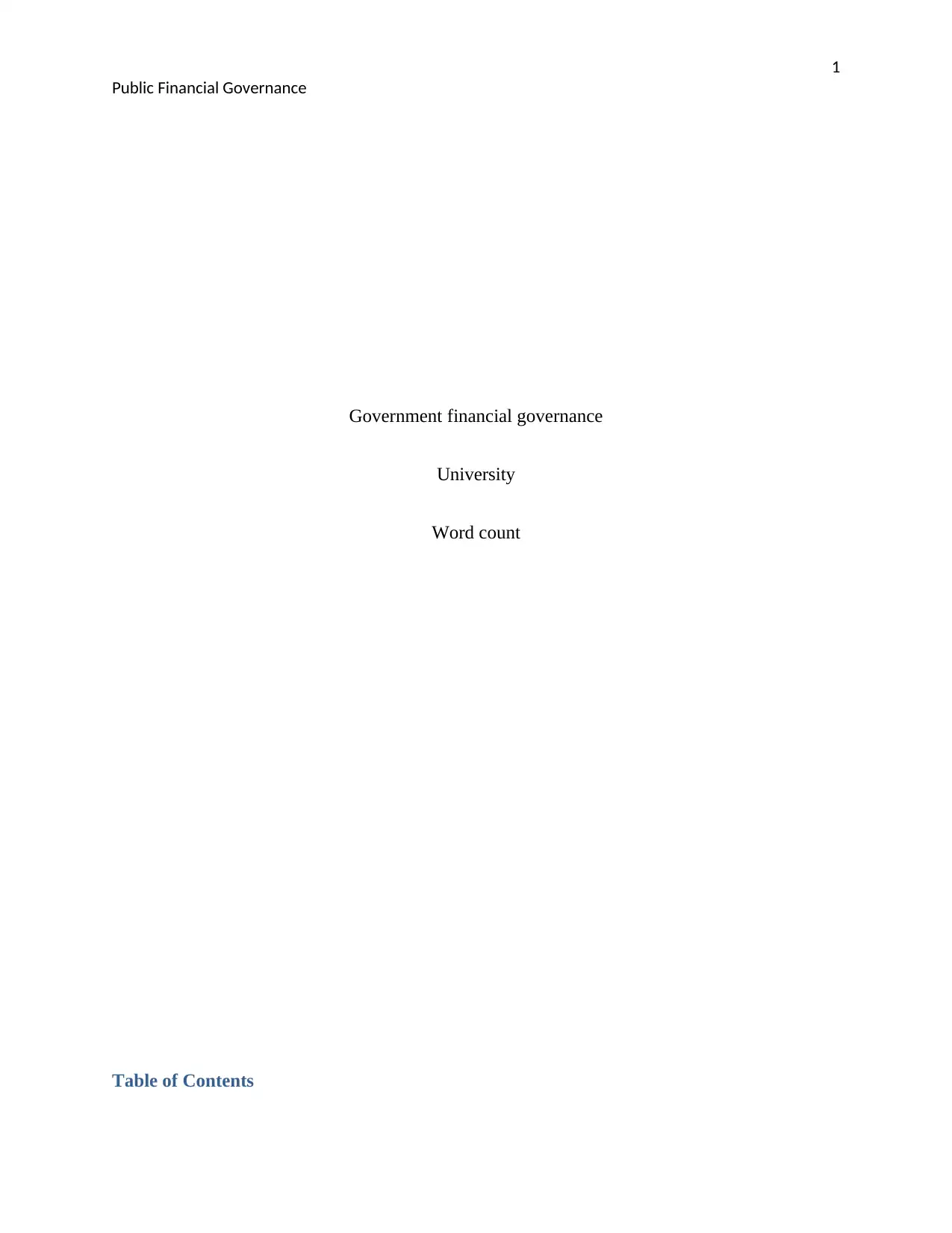
1
Public Financial Governance
Government financial governance
University
Word count
Table of Contents
Public Financial Governance
Government financial governance
University
Word count
Table of Contents
Paraphrase This Document
Need a fresh take? Get an instant paraphrase of this document with our AI Paraphraser
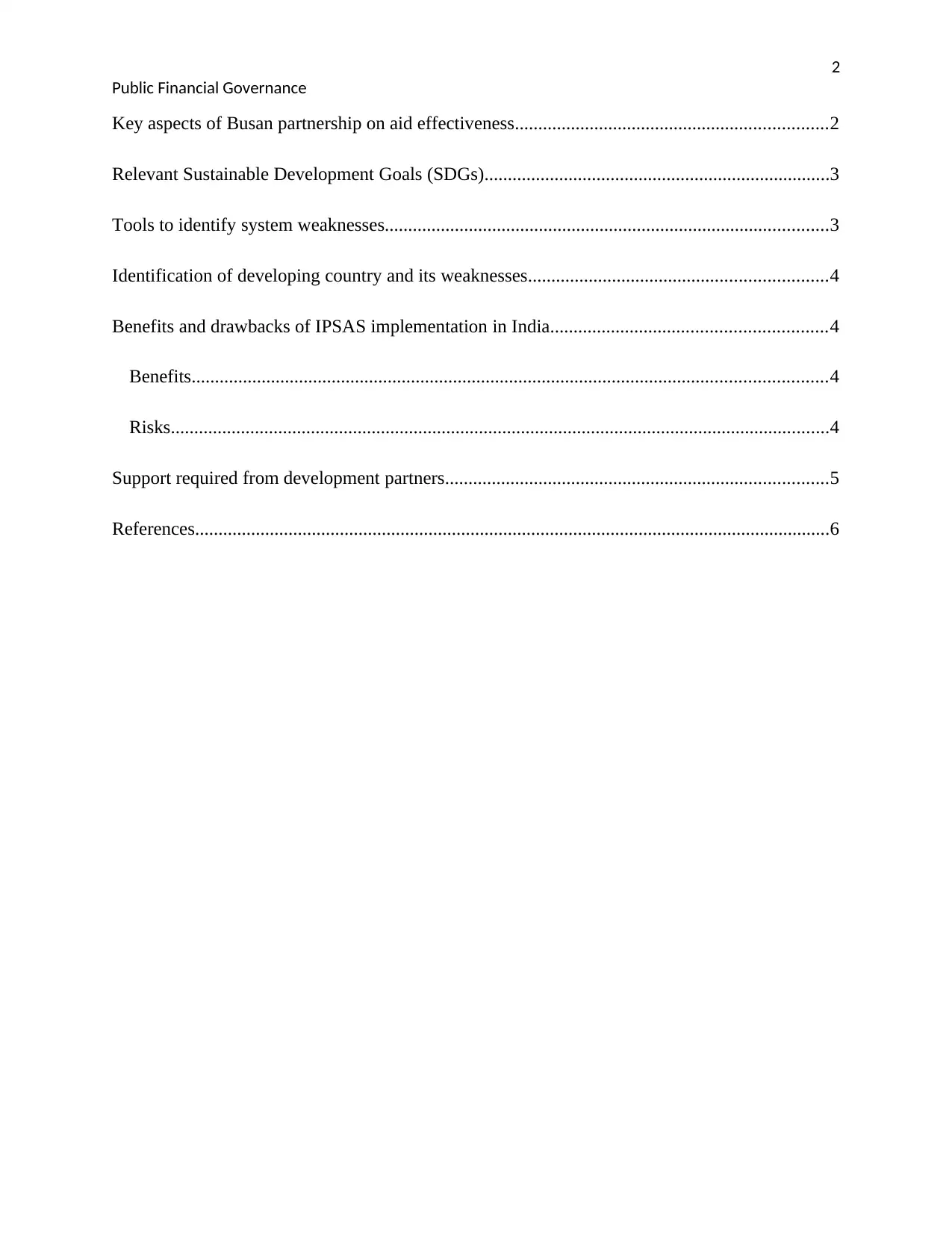
2
Public Financial Governance
Key aspects of Busan partnership on aid effectiveness...................................................................2
Relevant Sustainable Development Goals (SDGs)..........................................................................3
Tools to identify system weaknesses...............................................................................................3
Identification of developing country and its weaknesses................................................................4
Benefits and drawbacks of IPSAS implementation in India...........................................................4
Benefits........................................................................................................................................4
Risks.............................................................................................................................................4
Support required from development partners..................................................................................5
References........................................................................................................................................6
Public Financial Governance
Key aspects of Busan partnership on aid effectiveness...................................................................2
Relevant Sustainable Development Goals (SDGs)..........................................................................3
Tools to identify system weaknesses...............................................................................................3
Identification of developing country and its weaknesses................................................................4
Benefits and drawbacks of IPSAS implementation in India...........................................................4
Benefits........................................................................................................................................4
Risks.............................................................................................................................................4
Support required from development partners..................................................................................5
References........................................................................................................................................6
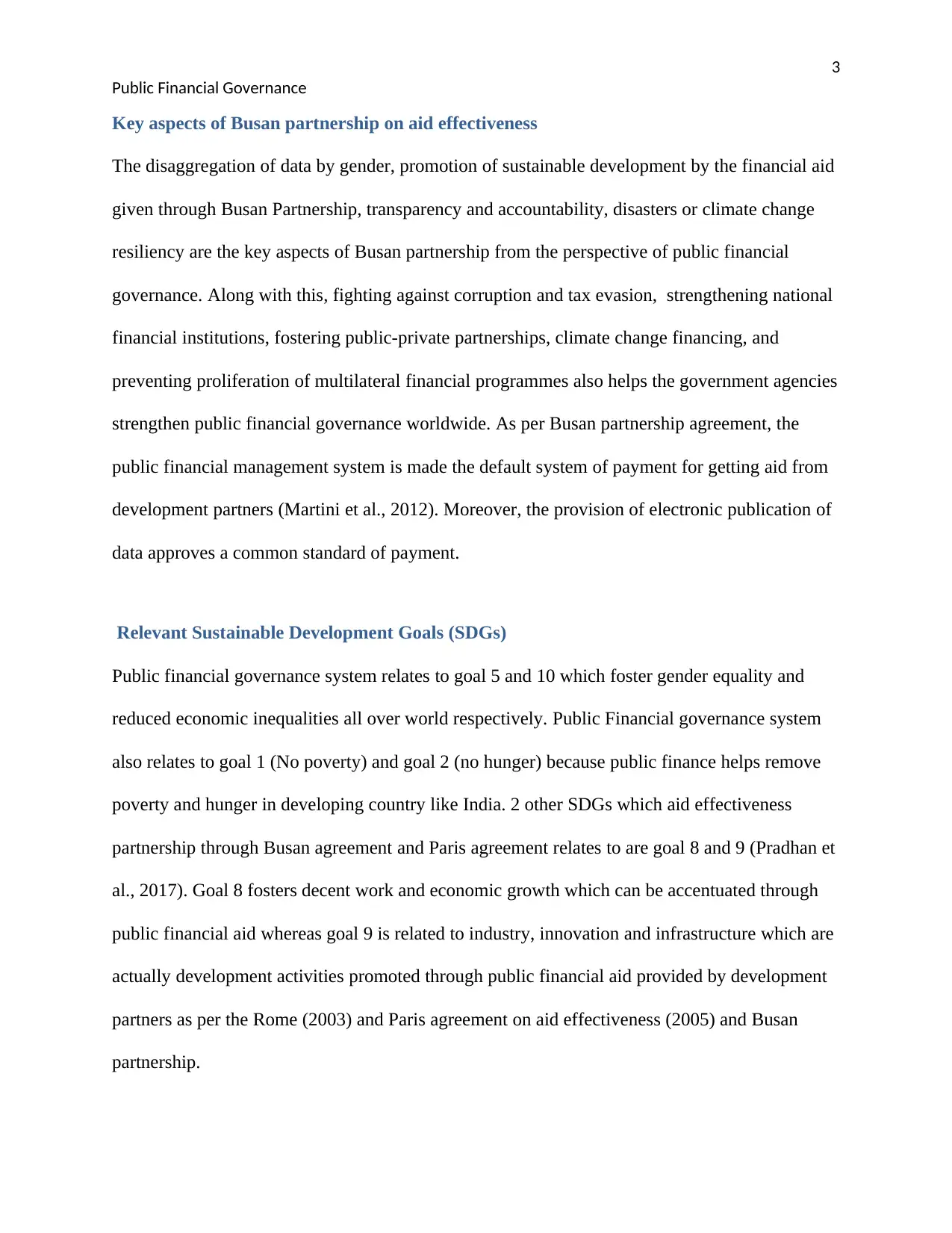
3
Public Financial Governance
Key aspects of Busan partnership on aid effectiveness
The disaggregation of data by gender, promotion of sustainable development by the financial aid
given through Busan Partnership, transparency and accountability, disasters or climate change
resiliency are the key aspects of Busan partnership from the perspective of public financial
governance. Along with this, fighting against corruption and tax evasion, strengthening national
financial institutions, fostering public-private partnerships, climate change financing, and
preventing proliferation of multilateral financial programmes also helps the government agencies
strengthen public financial governance worldwide. As per Busan partnership agreement, the
public financial management system is made the default system of payment for getting aid from
development partners (Martini et al., 2012). Moreover, the provision of electronic publication of
data approves a common standard of payment.
Relevant Sustainable Development Goals (SDGs)
Public financial governance system relates to goal 5 and 10 which foster gender equality and
reduced economic inequalities all over world respectively. Public Financial governance system
also relates to goal 1 (No poverty) and goal 2 (no hunger) because public finance helps remove
poverty and hunger in developing country like India. 2 other SDGs which aid effectiveness
partnership through Busan agreement and Paris agreement relates to are goal 8 and 9 (Pradhan et
al., 2017). Goal 8 fosters decent work and economic growth which can be accentuated through
public financial aid whereas goal 9 is related to industry, innovation and infrastructure which are
actually development activities promoted through public financial aid provided by development
partners as per the Rome (2003) and Paris agreement on aid effectiveness (2005) and Busan
partnership.
Public Financial Governance
Key aspects of Busan partnership on aid effectiveness
The disaggregation of data by gender, promotion of sustainable development by the financial aid
given through Busan Partnership, transparency and accountability, disasters or climate change
resiliency are the key aspects of Busan partnership from the perspective of public financial
governance. Along with this, fighting against corruption and tax evasion, strengthening national
financial institutions, fostering public-private partnerships, climate change financing, and
preventing proliferation of multilateral financial programmes also helps the government agencies
strengthen public financial governance worldwide. As per Busan partnership agreement, the
public financial management system is made the default system of payment for getting aid from
development partners (Martini et al., 2012). Moreover, the provision of electronic publication of
data approves a common standard of payment.
Relevant Sustainable Development Goals (SDGs)
Public financial governance system relates to goal 5 and 10 which foster gender equality and
reduced economic inequalities all over world respectively. Public Financial governance system
also relates to goal 1 (No poverty) and goal 2 (no hunger) because public finance helps remove
poverty and hunger in developing country like India. 2 other SDGs which aid effectiveness
partnership through Busan agreement and Paris agreement relates to are goal 8 and 9 (Pradhan et
al., 2017). Goal 8 fosters decent work and economic growth which can be accentuated through
public financial aid whereas goal 9 is related to industry, innovation and infrastructure which are
actually development activities promoted through public financial aid provided by development
partners as per the Rome (2003) and Paris agreement on aid effectiveness (2005) and Busan
partnership.
⊘ This is a preview!⊘
Do you want full access?
Subscribe today to unlock all pages.

Trusted by 1+ million students worldwide
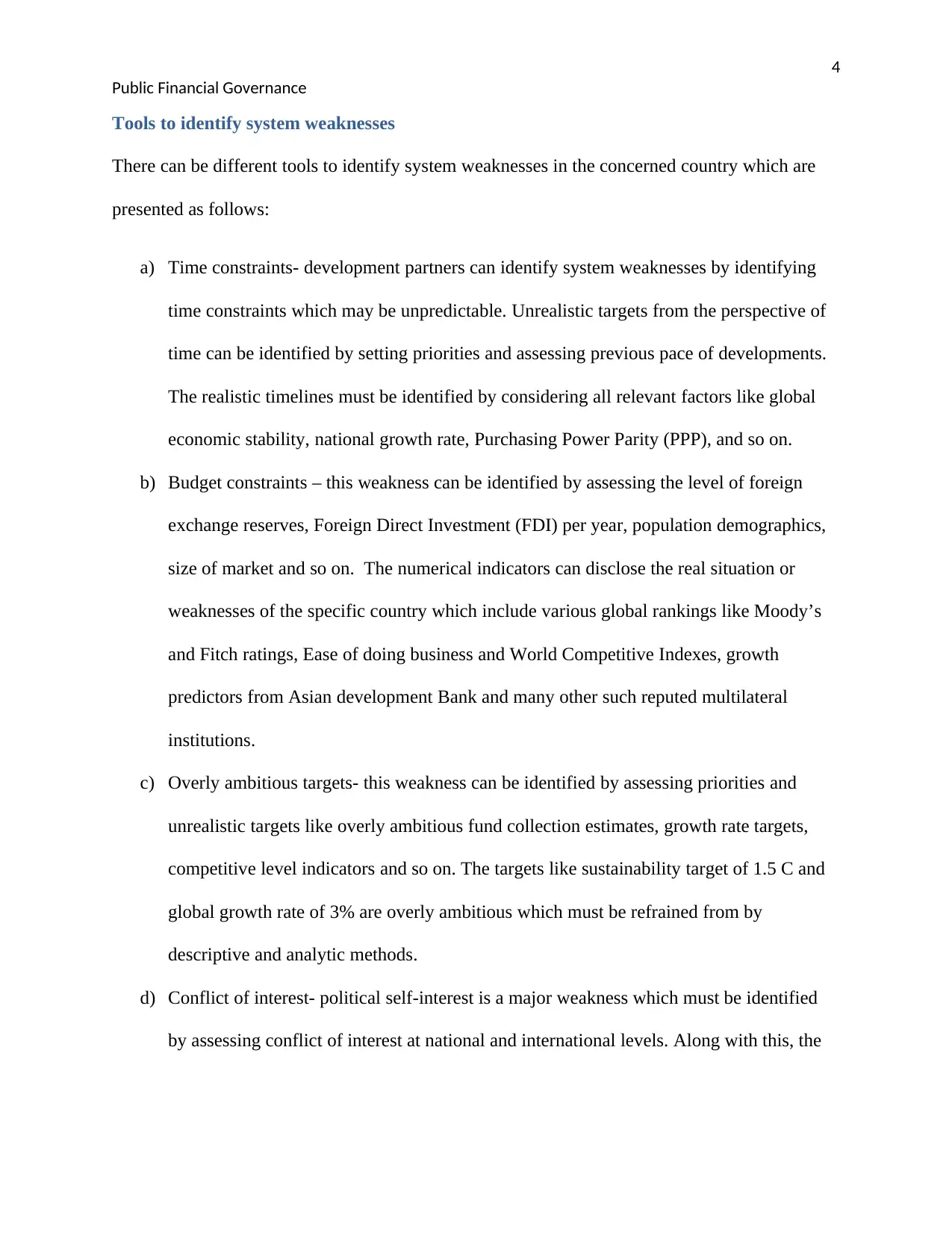
4
Public Financial Governance
Tools to identify system weaknesses
There can be different tools to identify system weaknesses in the concerned country which are
presented as follows:
a) Time constraints- development partners can identify system weaknesses by identifying
time constraints which may be unpredictable. Unrealistic targets from the perspective of
time can be identified by setting priorities and assessing previous pace of developments.
The realistic timelines must be identified by considering all relevant factors like global
economic stability, national growth rate, Purchasing Power Parity (PPP), and so on.
b) Budget constraints – this weakness can be identified by assessing the level of foreign
exchange reserves, Foreign Direct Investment (FDI) per year, population demographics,
size of market and so on. The numerical indicators can disclose the real situation or
weaknesses of the specific country which include various global rankings like Moody’s
and Fitch ratings, Ease of doing business and World Competitive Indexes, growth
predictors from Asian development Bank and many other such reputed multilateral
institutions.
c) Overly ambitious targets- this weakness can be identified by assessing priorities and
unrealistic targets like overly ambitious fund collection estimates, growth rate targets,
competitive level indicators and so on. The targets like sustainability target of 1.5 C and
global growth rate of 3% are overly ambitious which must be refrained from by
descriptive and analytic methods.
d) Conflict of interest- political self-interest is a major weakness which must be identified
by assessing conflict of interest at national and international levels. Along with this, the
Public Financial Governance
Tools to identify system weaknesses
There can be different tools to identify system weaknesses in the concerned country which are
presented as follows:
a) Time constraints- development partners can identify system weaknesses by identifying
time constraints which may be unpredictable. Unrealistic targets from the perspective of
time can be identified by setting priorities and assessing previous pace of developments.
The realistic timelines must be identified by considering all relevant factors like global
economic stability, national growth rate, Purchasing Power Parity (PPP), and so on.
b) Budget constraints – this weakness can be identified by assessing the level of foreign
exchange reserves, Foreign Direct Investment (FDI) per year, population demographics,
size of market and so on. The numerical indicators can disclose the real situation or
weaknesses of the specific country which include various global rankings like Moody’s
and Fitch ratings, Ease of doing business and World Competitive Indexes, growth
predictors from Asian development Bank and many other such reputed multilateral
institutions.
c) Overly ambitious targets- this weakness can be identified by assessing priorities and
unrealistic targets like overly ambitious fund collection estimates, growth rate targets,
competitive level indicators and so on. The targets like sustainability target of 1.5 C and
global growth rate of 3% are overly ambitious which must be refrained from by
descriptive and analytic methods.
d) Conflict of interest- political self-interest is a major weakness which must be identified
by assessing conflict of interest at national and international levels. Along with this, the
Paraphrase This Document
Need a fresh take? Get an instant paraphrase of this document with our AI Paraphraser
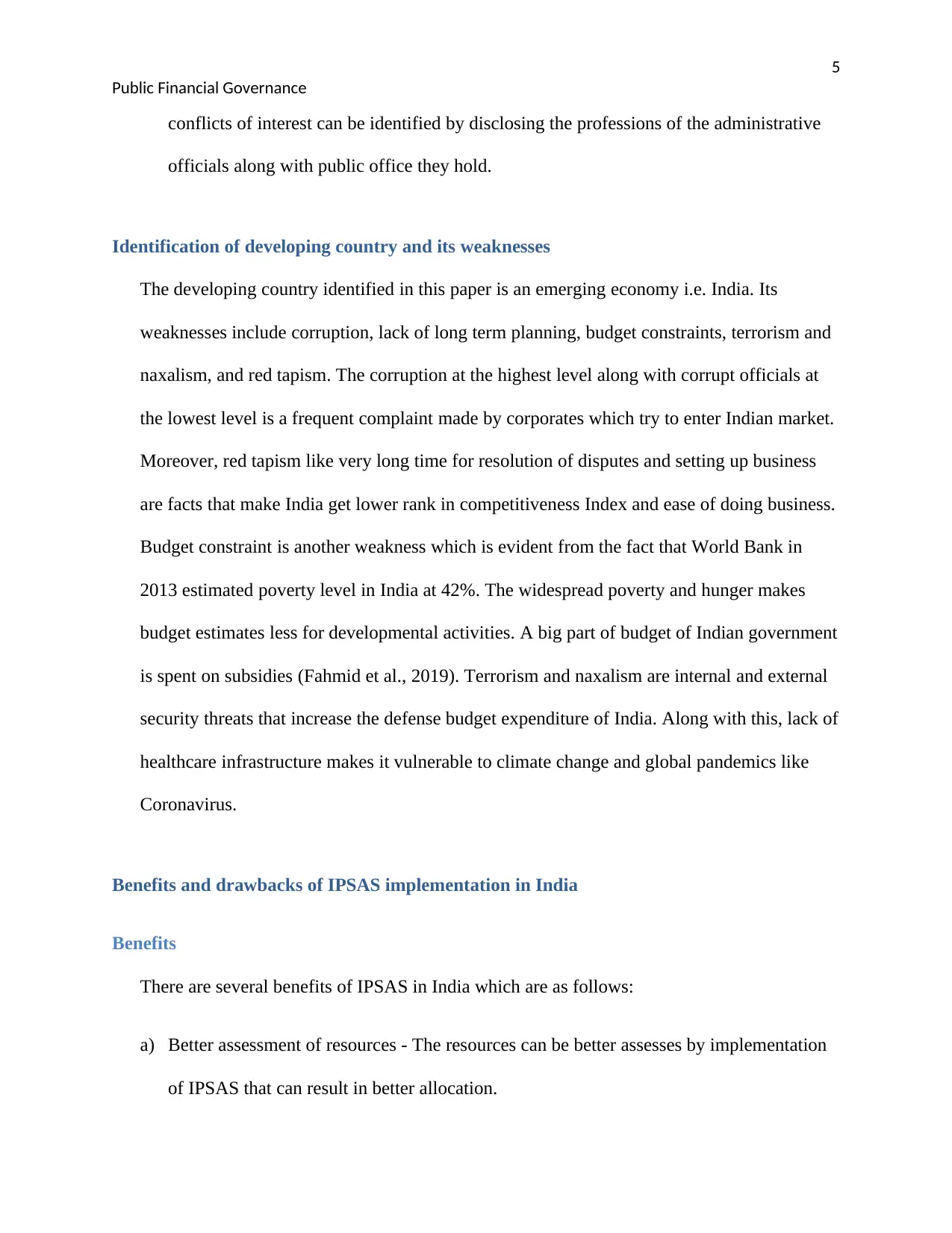
5
Public Financial Governance
conflicts of interest can be identified by disclosing the professions of the administrative
officials along with public office they hold.
Identification of developing country and its weaknesses
The developing country identified in this paper is an emerging economy i.e. India. Its
weaknesses include corruption, lack of long term planning, budget constraints, terrorism and
naxalism, and red tapism. The corruption at the highest level along with corrupt officials at
the lowest level is a frequent complaint made by corporates which try to enter Indian market.
Moreover, red tapism like very long time for resolution of disputes and setting up business
are facts that make India get lower rank in competitiveness Index and ease of doing business.
Budget constraint is another weakness which is evident from the fact that World Bank in
2013 estimated poverty level in India at 42%. The widespread poverty and hunger makes
budget estimates less for developmental activities. A big part of budget of Indian government
is spent on subsidies (Fahmid et al., 2019). Terrorism and naxalism are internal and external
security threats that increase the defense budget expenditure of India. Along with this, lack of
healthcare infrastructure makes it vulnerable to climate change and global pandemics like
Coronavirus.
Benefits and drawbacks of IPSAS implementation in India
Benefits
There are several benefits of IPSAS in India which are as follows:
a) Better assessment of resources - The resources can be better assesses by implementation
of IPSAS that can result in better allocation.
Public Financial Governance
conflicts of interest can be identified by disclosing the professions of the administrative
officials along with public office they hold.
Identification of developing country and its weaknesses
The developing country identified in this paper is an emerging economy i.e. India. Its
weaknesses include corruption, lack of long term planning, budget constraints, terrorism and
naxalism, and red tapism. The corruption at the highest level along with corrupt officials at
the lowest level is a frequent complaint made by corporates which try to enter Indian market.
Moreover, red tapism like very long time for resolution of disputes and setting up business
are facts that make India get lower rank in competitiveness Index and ease of doing business.
Budget constraint is another weakness which is evident from the fact that World Bank in
2013 estimated poverty level in India at 42%. The widespread poverty and hunger makes
budget estimates less for developmental activities. A big part of budget of Indian government
is spent on subsidies (Fahmid et al., 2019). Terrorism and naxalism are internal and external
security threats that increase the defense budget expenditure of India. Along with this, lack of
healthcare infrastructure makes it vulnerable to climate change and global pandemics like
Coronavirus.
Benefits and drawbacks of IPSAS implementation in India
Benefits
There are several benefits of IPSAS in India which are as follows:
a) Better assessment of resources - The resources can be better assesses by implementation
of IPSAS that can result in better allocation.
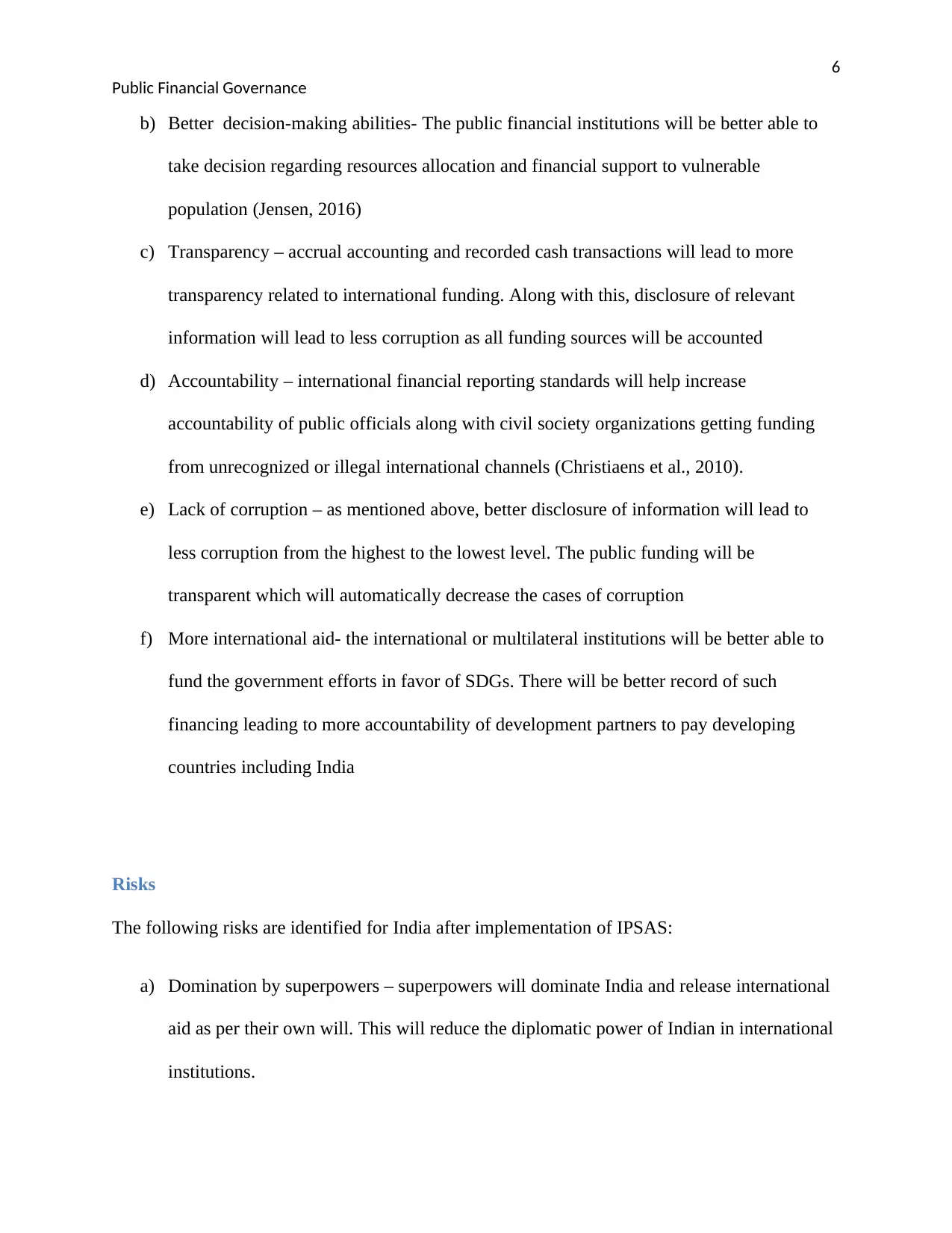
6
Public Financial Governance
b) Better decision-making abilities- The public financial institutions will be better able to
take decision regarding resources allocation and financial support to vulnerable
population (Jensen, 2016)
c) Transparency – accrual accounting and recorded cash transactions will lead to more
transparency related to international funding. Along with this, disclosure of relevant
information will lead to less corruption as all funding sources will be accounted
d) Accountability – international financial reporting standards will help increase
accountability of public officials along with civil society organizations getting funding
from unrecognized or illegal international channels (Christiaens et al., 2010).
e) Lack of corruption – as mentioned above, better disclosure of information will lead to
less corruption from the highest to the lowest level. The public funding will be
transparent which will automatically decrease the cases of corruption
f) More international aid- the international or multilateral institutions will be better able to
fund the government efforts in favor of SDGs. There will be better record of such
financing leading to more accountability of development partners to pay developing
countries including India
Risks
The following risks are identified for India after implementation of IPSAS:
a) Domination by superpowers – superpowers will dominate India and release international
aid as per their own will. This will reduce the diplomatic power of Indian in international
institutions.
Public Financial Governance
b) Better decision-making abilities- The public financial institutions will be better able to
take decision regarding resources allocation and financial support to vulnerable
population (Jensen, 2016)
c) Transparency – accrual accounting and recorded cash transactions will lead to more
transparency related to international funding. Along with this, disclosure of relevant
information will lead to less corruption as all funding sources will be accounted
d) Accountability – international financial reporting standards will help increase
accountability of public officials along with civil society organizations getting funding
from unrecognized or illegal international channels (Christiaens et al., 2010).
e) Lack of corruption – as mentioned above, better disclosure of information will lead to
less corruption from the highest to the lowest level. The public funding will be
transparent which will automatically decrease the cases of corruption
f) More international aid- the international or multilateral institutions will be better able to
fund the government efforts in favor of SDGs. There will be better record of such
financing leading to more accountability of development partners to pay developing
countries including India
Risks
The following risks are identified for India after implementation of IPSAS:
a) Domination by superpowers – superpowers will dominate India and release international
aid as per their own will. This will reduce the diplomatic power of Indian in international
institutions.
⊘ This is a preview!⊘
Do you want full access?
Subscribe today to unlock all pages.

Trusted by 1+ million students worldwide
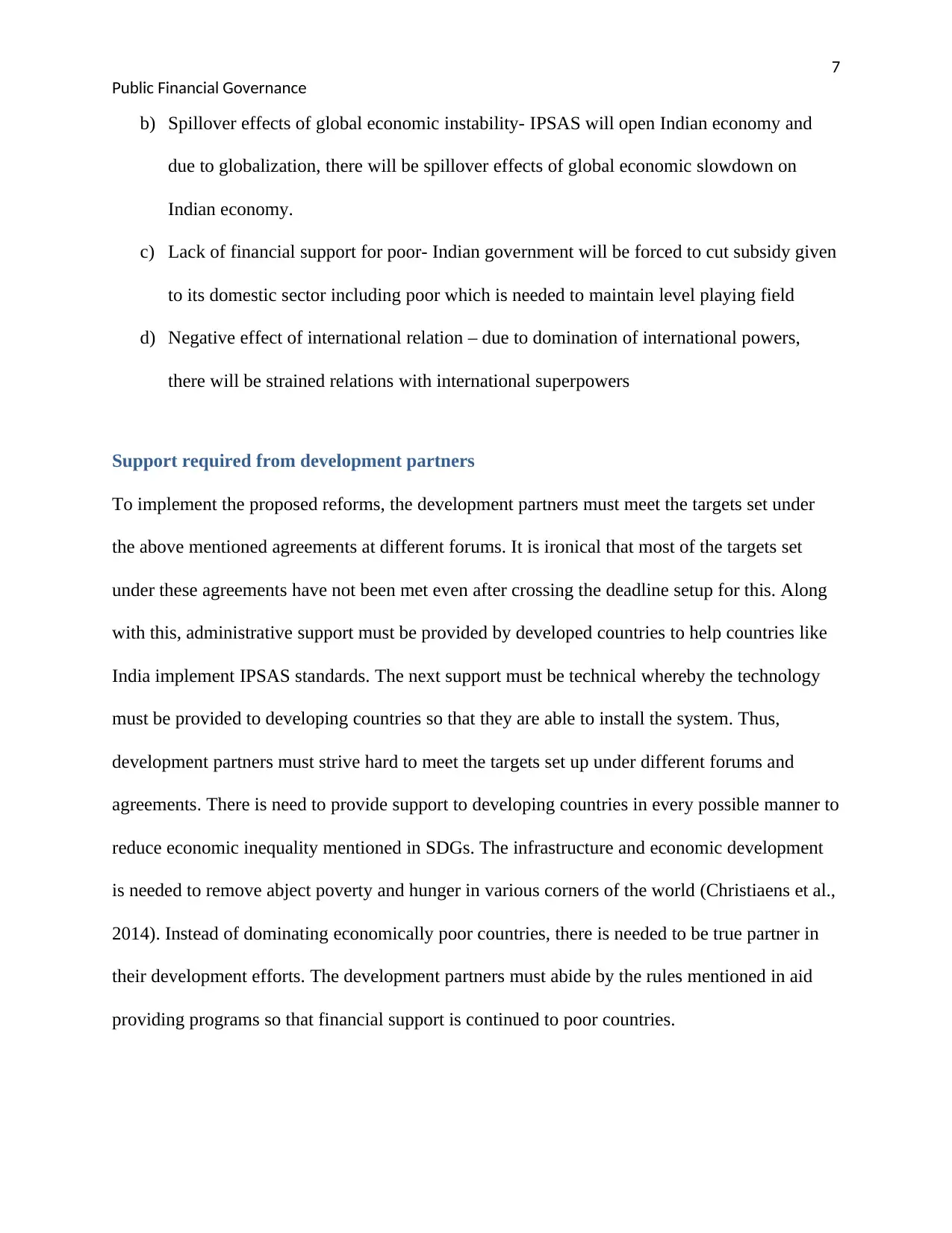
7
Public Financial Governance
b) Spillover effects of global economic instability- IPSAS will open Indian economy and
due to globalization, there will be spillover effects of global economic slowdown on
Indian economy.
c) Lack of financial support for poor- Indian government will be forced to cut subsidy given
to its domestic sector including poor which is needed to maintain level playing field
d) Negative effect of international relation – due to domination of international powers,
there will be strained relations with international superpowers
Support required from development partners
To implement the proposed reforms, the development partners must meet the targets set under
the above mentioned agreements at different forums. It is ironical that most of the targets set
under these agreements have not been met even after crossing the deadline setup for this. Along
with this, administrative support must be provided by developed countries to help countries like
India implement IPSAS standards. The next support must be technical whereby the technology
must be provided to developing countries so that they are able to install the system. Thus,
development partners must strive hard to meet the targets set up under different forums and
agreements. There is need to provide support to developing countries in every possible manner to
reduce economic inequality mentioned in SDGs. The infrastructure and economic development
is needed to remove abject poverty and hunger in various corners of the world (Christiaens et al.,
2014). Instead of dominating economically poor countries, there is needed to be true partner in
their development efforts. The development partners must abide by the rules mentioned in aid
providing programs so that financial support is continued to poor countries.
Public Financial Governance
b) Spillover effects of global economic instability- IPSAS will open Indian economy and
due to globalization, there will be spillover effects of global economic slowdown on
Indian economy.
c) Lack of financial support for poor- Indian government will be forced to cut subsidy given
to its domestic sector including poor which is needed to maintain level playing field
d) Negative effect of international relation – due to domination of international powers,
there will be strained relations with international superpowers
Support required from development partners
To implement the proposed reforms, the development partners must meet the targets set under
the above mentioned agreements at different forums. It is ironical that most of the targets set
under these agreements have not been met even after crossing the deadline setup for this. Along
with this, administrative support must be provided by developed countries to help countries like
India implement IPSAS standards. The next support must be technical whereby the technology
must be provided to developing countries so that they are able to install the system. Thus,
development partners must strive hard to meet the targets set up under different forums and
agreements. There is need to provide support to developing countries in every possible manner to
reduce economic inequality mentioned in SDGs. The infrastructure and economic development
is needed to remove abject poverty and hunger in various corners of the world (Christiaens et al.,
2014). Instead of dominating economically poor countries, there is needed to be true partner in
their development efforts. The development partners must abide by the rules mentioned in aid
providing programs so that financial support is continued to poor countries.
Paraphrase This Document
Need a fresh take? Get an instant paraphrase of this document with our AI Paraphraser
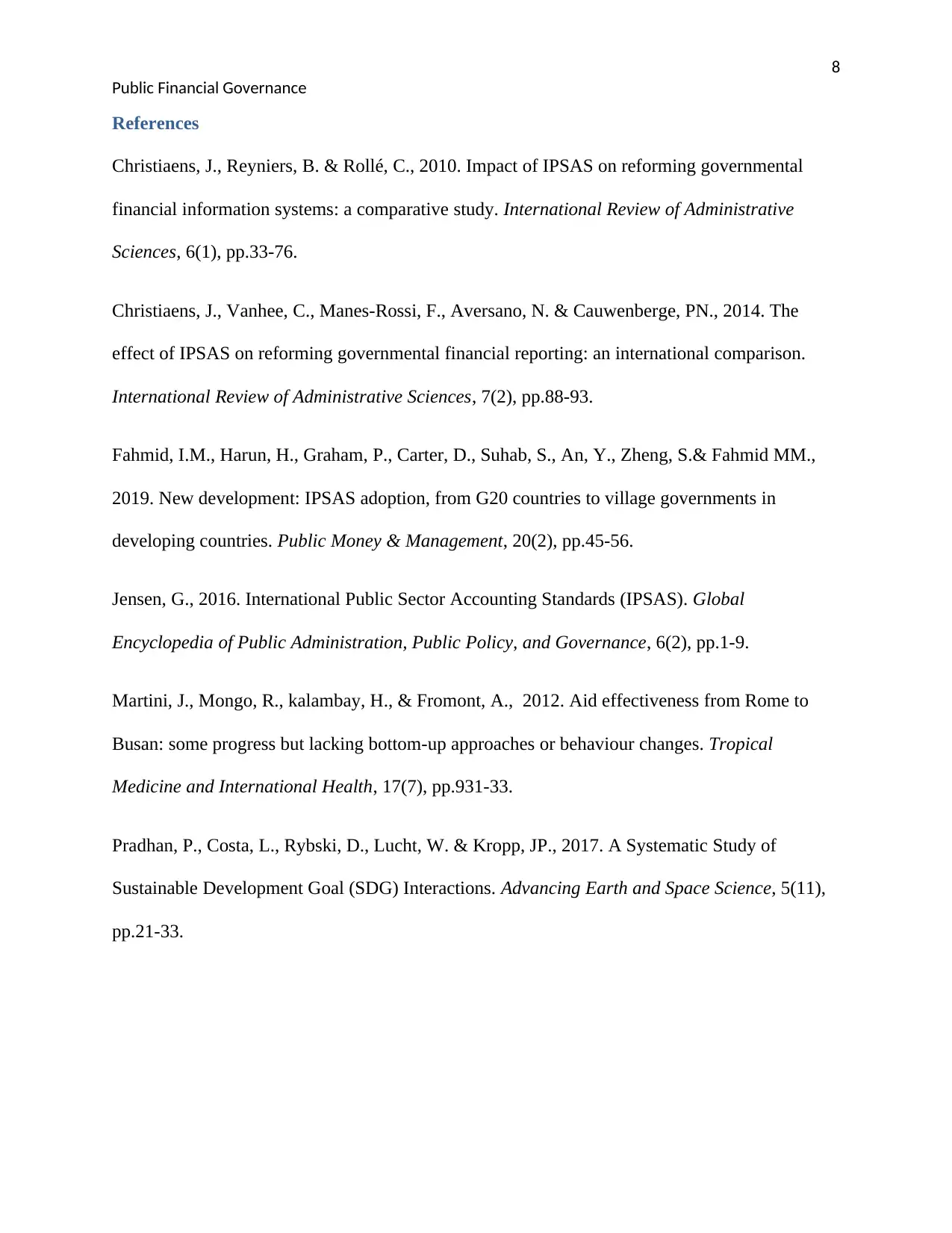
8
Public Financial Governance
References
Christiaens, J., Reyniers, B. & Rollé, C., 2010. Impact of IPSAS on reforming governmental
financial information systems: a comparative study. International Review of Administrative
Sciences, 6(1), pp.33-76.
Christiaens, J., Vanhee, C., Manes-Rossi, F., Aversano, N. & Cauwenberge, PN., 2014. The
effect of IPSAS on reforming governmental financial reporting: an international comparison.
International Review of Administrative Sciences, 7(2), pp.88-93.
Fahmid, I.M., Harun, H., Graham, P., Carter, D., Suhab, S., An, Y., Zheng, S.& Fahmid MM.,
2019. New development: IPSAS adoption, from G20 countries to village governments in
developing countries. Public Money & Management, 20(2), pp.45-56.
Jensen, G., 2016. International Public Sector Accounting Standards (IPSAS). Global
Encyclopedia of Public Administration, Public Policy, and Governance, 6(2), pp.1-9.
Martini, J., Mongo, R., kalambay, H., & Fromont, A., 2012. Aid effectiveness from Rome to
Busan: some progress but lacking bottom-up approaches or behaviour changes. Tropical
Medicine and International Health, 17(7), pp.931-33.
Pradhan, P., Costa, L., Rybski, D., Lucht, W. & Kropp, JP., 2017. A Systematic Study of
Sustainable Development Goal (SDG) Interactions. Advancing Earth and Space Science, 5(11),
pp.21-33.
Public Financial Governance
References
Christiaens, J., Reyniers, B. & Rollé, C., 2010. Impact of IPSAS on reforming governmental
financial information systems: a comparative study. International Review of Administrative
Sciences, 6(1), pp.33-76.
Christiaens, J., Vanhee, C., Manes-Rossi, F., Aversano, N. & Cauwenberge, PN., 2014. The
effect of IPSAS on reforming governmental financial reporting: an international comparison.
International Review of Administrative Sciences, 7(2), pp.88-93.
Fahmid, I.M., Harun, H., Graham, P., Carter, D., Suhab, S., An, Y., Zheng, S.& Fahmid MM.,
2019. New development: IPSAS adoption, from G20 countries to village governments in
developing countries. Public Money & Management, 20(2), pp.45-56.
Jensen, G., 2016. International Public Sector Accounting Standards (IPSAS). Global
Encyclopedia of Public Administration, Public Policy, and Governance, 6(2), pp.1-9.
Martini, J., Mongo, R., kalambay, H., & Fromont, A., 2012. Aid effectiveness from Rome to
Busan: some progress but lacking bottom-up approaches or behaviour changes. Tropical
Medicine and International Health, 17(7), pp.931-33.
Pradhan, P., Costa, L., Rybski, D., Lucht, W. & Kropp, JP., 2017. A Systematic Study of
Sustainable Development Goal (SDG) Interactions. Advancing Earth and Space Science, 5(11),
pp.21-33.
1 out of 8
Related Documents
Your All-in-One AI-Powered Toolkit for Academic Success.
+13062052269
info@desklib.com
Available 24*7 on WhatsApp / Email
![[object Object]](/_next/static/media/star-bottom.7253800d.svg)
Unlock your academic potential
Copyright © 2020–2025 A2Z Services. All Rights Reserved. Developed and managed by ZUCOL.




